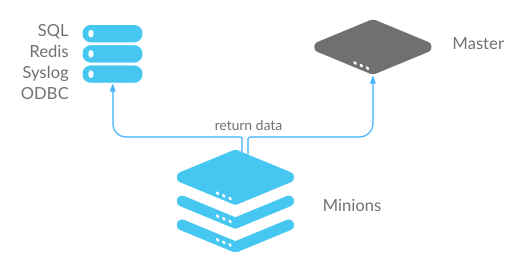STORING JOB RESULTS IN AN EXTERNAL SYSTEM
After a job executes, job results are returned to the Salt Master by each Salt Minion. These results are stored in the Default Job Cache.
作业执行后,作业结果由每个salt minion返回给salt master。这些结果存储在默认作业缓存中。
In addition to the Default Job Cache, Salt provides two additional mechanisms to send job results to other systems (databases, local syslog, and others):
除了缺省的作业缓存之外,Salt还提供了两种附加的机制来将作业结果发送给其他系统(数据库、本地系统日志等):
- External Job Cache 外部job缓存
- Master Job Cache Maste job缓存
The major difference between these two mechanism is from where results are returned (from the Salt Master or Salt Minion). Configuring either of these options will also make the Jobs Runner functions to automatically query the remote stores for information.
这两种机制之间的主要区别是从结果返回(从salt master或salt minion)。配置这些选项中的任何一个也将使Jobs Runner functions能自动查询远程存储的信息。
external job cache - minion-side returner
When an External Job Cache is configured, data is returned to the Default Job Cache on the Salt Master like usual, and then results are also sent to an External Job Cache using a Salt returner module running on the Salt Minion.
当配置外部作业缓存时,数据像往常一样返回到salt master上的缺省作业缓存,然后使用在salt minion上运行的salt返回器模块将结果发送到外部作业缓存。

- Advantages: Data is stored without placing additional load on the Salt Master. 优点:数据存储,而不增加 Salt Master上的额外负载。
- Disadvantages: Each Salt Minion connects to the external job cache, which can result in a large number of connections. Also requires additional configuration to get returner module settings on all Salt Minions. 缺点:每个salt minion连接到外部作业缓存,这可能导致大量的连接。还需要额外的配置,以获得返回模块设置在所有salt minions。
master job cache - master-side returner
New in version 2014.7.0.
Instead of configuring an External Job Cache on each Salt Minion, you can configure the Master Job Cache to send job results from the Salt Master instead. In this configuration, Salt Minions send data to the Default Job Cache as usual, and then the Salt Master sends the data to the external system using a Salt returner module running on the Salt Master.
代替配置每个salt minion上的外部作业缓存,可以配置Master job cache以salt master发送作业结果。在这种配置中,salt minion像往常一样将数据发送到默认作业缓存,然后salt master使用运行在salt master上的salt返回器模块将数据发送到外部系统。

- Advantages: A single connection is required to the external system. This is preferred for databases and similar systems.优点:外部系统需要一个连接。这对于数据库和类似系统是优选的。
- Disadvantages: Places additional load on your Salt Master. 缺点:给你的salt master 增加额外的负担。
configure an external or master job cache
step 1: understand salt returners 了解salt returners
Before you configure a job cache, it is essential to understand Salt returner modules ("returners"). Returners are pluggable Salt Modules that take the data returned by jobs, and then perform any necessary steps to send the data to an external system. For example, a returner might establish a connection, authenticate, and then format and transfer data.
在配置job cache之前,了解Salt returner 模块("returners")是绝对有必要的。Returners 是可插拔的Salt模块,它接收作业返回的数据,然后执行任何必要的步骤将数据发送到外部系统。例如,返回者可以建立连接、认证、然后格式化和传输数据。
The Salt Returner system provides the core functionality used by the External and Master Job Cache systems, and the same returners are used by both systems.
Salt Returnner系统提供External和Master Job Cache系统所使用的核心功能,并且两个系统都使用相同的returnners。
Salt currently provides many different returners that let you connect to a wide variety of systems. A complete list is available at all Salt returners. Each returner is configured differently, so make sure you read and follow the instructions linked from that page.
Salt目前提供了许多不同的returners, 让你连接到各种各样的系统。所有Salt returners都有一份完整的清单。每个return的配置不同,所以请务必阅读并遵循从该页面链接的指令。
For example, the MySQL returner requires: 比如,MySQL returnner的规定:
- A database created using provided schema (structure is available at
MySQL returner) - A user created with privileges to the database
- Optional SSL configuration
A simpler returner, such as Slack or HipChat, requires:
- An API key/version
- The target channel/room
- The username that should be used to send the message
step 2: configure the returner
After you understand the configuration and have the external system ready, the configuration requirements must be declared.
在了解配置并使外部系统准备好之后,必须声明配置要求。
EXTERNAL JOB CACHE
The returner configuration settings can be declared in the Salt Minion configuration file, the Minion's pillar data, or the Minion's grains.
returner声明设置可以在salt minion配置文件配置,Minion的pillar数据或Minion的grains声明。
If external_job_cache configuration settings are specified in more than one place, the options are retrieved in the following order. The first configuration location that is found is the one that will be used.
如果在多个地方指定外部 external_job_cache,则按以下顺序检索选项。找到的第一个配置位置是将被使用的位置。
- Minion configuration file
- Minion's grains
- Minion's pillar data
MASTER JOB CACHE
The returner configuration settings for the Master Job Cache should be declared in the Salt Master's configuration file.
Master Job Cache 的返回器配置设置应在Salt Master'的配置文件中声明。
CONFIGURATION FILE EXAMPLES
MySQL requires:
mysql.host: 'salt' mysql.user: 'salt' mysql.pass: 'salt' mysql.db: 'salt' mysql.port: 3306
Slack requires:
slack.channel: 'channel' slack.api_key: 'key' slack.from_name: 'name'
After you have configured the returner and added settings to the configuration file, you can enable the External or Master Job Cache.
step 3: enable the external or master job cache
Configuration is a single line that specifies an already-configured returner to use to send all job data to an external system.
配置是一个单行,指定已配置的returner用于将所有作业数据发送到外部系统。
EXTERNAL JOB CACHE
To enable a returner as the External Job Cache (Minion-side), add the following line to the Salt Master configuration file:
若要使returner作为 External Job Cache (Minion-side),请将以下行添加到Salt Master 配置文件中:
ext_job_cache: <returner>
For example: 例如:
ext_job_cache: mysql
注意: When configuring an External Job Cache (Minion-side), the returner settings are added to the Minion configuration file, but the External Job Cache setting is configured in the Master configuration file. 当配置 External Job Cache (Minion-side)时,将returner设置添加到 Minion配置文件中,但 External Job Cache设置在Master配置文件中配置。
master job cache
To enable a returner as a Master Job Cache (Master-side), add the following line to the Salt Master configuration file:
若要使returner 作为Master Job Cache (Master-side), 请将以下行添加到Salt Master 配置文件中:
master_job_cache: <returner>
For example: 例如:
master_job_cache: mysql
Verify that the returner configuration settings are in the Master configuration file, and be sure to restart the salt-master service after you make configuration changes. (service salt-master restart).
验证returner配置设置在Master配置文件中,并确保在配置更改之后重新启动 salt-master 服务。(service salt-master restart)。